Empowering Frontline Workers with 3D Models and IoT Data
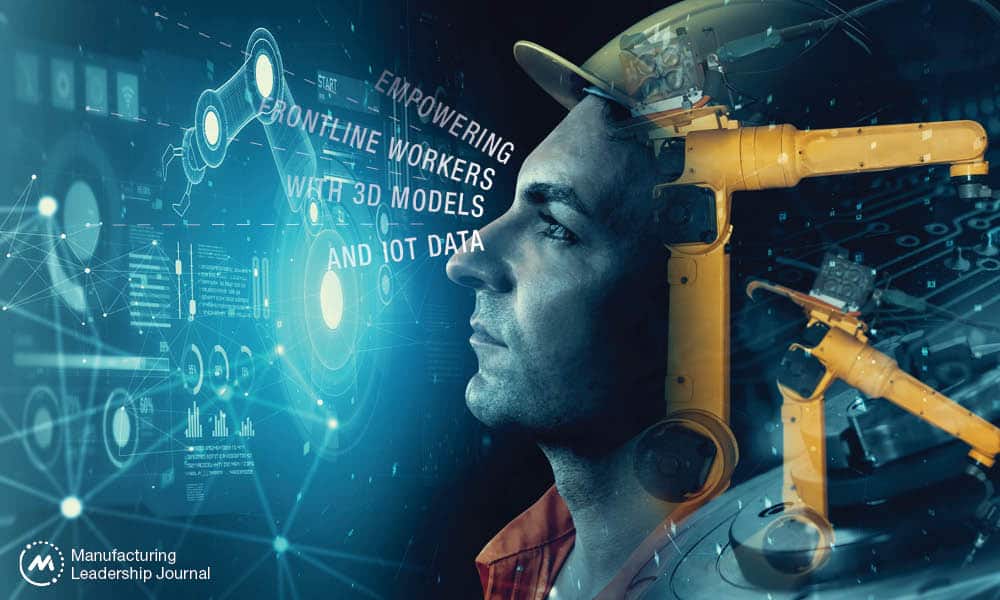
Advanced technology and data are helping manufacturers’ frontline workers become more productive.

TAKEAWAYS:
● The connected worker solution integrates MBD/E with IoT and AR to provide workers with real-time information, guidance, and feedback.
● Improved agility, compliance, and quality, increased efficiency, and empowered employees are just some benefits of the connected worker solution.
● Adopting a connected worker solution in manufacturing requires a strategic and flexible approach.
“Connected Frontline Workforce (CFW) applications are a strategic differentiator to successfully address daunting challenges in safety, sustainability, productivity, quality, and overall margin goals,” said Allison Kuhn, EHS/Sustainability, Future of Industrial Work Research Analyst, of LNS Research. “CFW applications are proven human-centric platforms that accelerate business value with real-time insights and knowledge management, leading to faster, better decisions.”
Discrete manufacturers face significant challenges, including global competition, rising customer expectations, increasing product complexity, and workforce shortage—all while needing to simultaneously capture significant improvements in productivity. These challenges necessitate a transformation towards agile, efficient, and resilient operations. Despite the automation of many dull, dirty, and dangerous tasks, frontline workers remain the vital component in this transformation. However, they are expected to perform today’s tasks at tomorrow’s speed with yesterday’s resources. A Forrester study1 found that 77 percent of frontline workers don’t have access to the technology they need to be productive. Strategic technological support is therefore crucial for actionable insights, enhanced human-machine interactions, effective collaborations across value chain, as well as for fostering improved decision-making and operational efficiency.
A model-based connected worker solution (hereafter called the “connected worker”) is a key technological enabler; it integrates model-based definitions and enterprise (MBD/E) with Internet-of-Things (IoT), augmented reality (AR), analytics, and artificial intelligence (AI). MBD/E, as a key facet of industrial digital transformation, uses 3D models as the authoritative source throughout the product lifecycle. The 3D model contains vital details like geometry, tolerance, manufacturing notes, as well as associated derivatives like manufacturing bill of materials, routing, work instructions, computer numerical control (CNC)/coordinate measuring machine (CMM) programs, control plan/characteristics, etc. With 62 percent of large manufacturers adopting or considering MBD/E strategies, and 57 percent of executives prioritizing them, according to Tech-Clarity2, the connected worker solution is timely and a booster to connected frontline worker initiative.

“The reality is that frontline workers are often expected to perform today’s tasks at tomorrow’s speed with yesterday’s resources.”
The strength of the connected worker lies in how 3D models amplify the impact of IoT, AR, analytics, and AI technologies, which have already been adopted or are being adopted by industry leaders to empower frontline workers. With the increasing adoption of MBD/E, these 3D models serve as a powerful booster by further enhancing the capabilities of frontline workers. The unique value that 3D models bring to connected workers includes
- Intuitive and immersive experience: Aligning with human visual and cognitive capabilities, 3D models combined with IoT and AR make it easier to understand complex real-time data, which speeds up decision-making and response times.
- One authoritative and always synchronized product and process data: As part of MBD/E, these models ensure that factory frontline workers/machines, and their upstream/downstream co-workers/systems, respectively, access consistent, updated information across the value chain.
The integration of 3D models with IoT, AR, analytics, and AI equips frontline workers with timely insights and ensures they are prepared to face the challenges of modern manufacturing, thereby enhancing productivity and competitiveness.
Benefits of the Connected Worker
The connected worker solution can help manufacturers achieve several benefits:
- Speed and agility: By providing workers with model-based work instructions, the solution can reduce the time and errors involved in manual and paper-based processes and enable faster and more flexible responses to changes and customer demands.
- Efficiency and cost: By connecting workers with model-based connected machines, the solution can optimize the use and performance of assets, and reduce downtime, waste, and maintenance costs.
- Quality and compliance: By enabling workers to perform end-of-line inspections and use data to solve problems, the solution can improve the quality and consistency of products and ensure compliance with standards and regulations.
- Frontline worker empowerment and engagement: Frontline workers benefit from on-the-job learn & do with intuitive work instructions in a 3D context, improved knowledge capture and sharing, and the elimination of non-value-added activities.
Connected Worker Use Cases and Case Studies
We present four examples of connected worker use cases that demonstrate how manufacturers can start with minimal investment yet reap significant benefits. These examples showcase practical and efficient applications of the connected worker concept in real-world scenarios.
1. Model-based Work Instructions and Execution
A case study of Vestas shows how a model-based connected worker solution can help workers assemble complex components with higher accuracy and efficiency, improving first-time build rate and better-quality outcomes.
Problem: Vestas had a dynamic build process, and detailed work instructions that were traditionally printed on hundreds of thousands of paper pages and sent out to more than 23,000 employees. Also, given the size and complexity of wind turbines, particularly with the recent uptick in global demand, Vestas employees required more in-context information to meet these challenges.
Solution: Vestas introduced PTC’s Manufacturing Solutions, which equipped machine operators with the relevant information needed to identify and complete tasks in the right sequence with the right tools—including role-specific digital work order information and instructions with rich CAD drawings and videos —all in a single interface. This solution will help ease the impact felt by the veteran employees retiring and combat the current volatility around employee retention.
2. Model-based Connected Machine
A large construction equipment manufacturer is exploring a model-based manufacturing strategy to avoid human errors and improve product and process quality by automating human-machine interaction with programmatic information extracted directly from the 3D model.
Problem: The manufacturer has many different types of machines, including welding, CNC, and CMM. There is a lot of manual work involved in copying and pasting engineering documents, process planning documents, control plans, and CNC/CMM programs between engineering and manufacturing operations. This results in significant delays in production preparation time and more errors in human transcription.
Solution: The manufacturer is implementing a model-based manufacturing strategy that starts with engineering by creating a single 3D product model that is leveraged by up to 100 downstream deliverables, including control characteristics details that flow automatically into welding, CNC, and CMM machines and which collects processing and testing results for further variation analysis.

“AR solutions help frontline workers view clear, detailed digital content in the context of their physical environment.”
3. End-of-line Inspection
A case study of Magna, an automotive supplier, shows how the solution can help workers inspect and verify the quality of products using AR and IoT devices, reducing defects and recalls.
Problem: There is very little room for error in the fast-paced automotive industry, and as vehicles become more complex, so does the assembly process. Many sequential steps need to happen within a given time frame. With manual processes and 2D paper-based instructions, training an operator on these steps is time consuming and challenging. Magna also had found that improperly fitted electrical plugs were passing continuity testing but then coming undone with movement—they required an extra layer of inspection for this part moving forward.
Solution: AR quality verification solutions help frontline workers view clear, detailed digital content in the context of their physical environment. PTC’s AR solution made it easy to create AR-guided tasks, checklists, and data capture. Magna used the AR solution to address its training outcomes, as trained workers can create first-person points of view of parts being assembled for trainees to follow. Training can also be enhanced with locational awareness, videos, images, and diagrams to provide extra content for new employees. Magna also used AR to enable operator inspection, intuitively creating quality inspection procedures that were more efficient and which reduced scrap, rework, and defects.
4. Closed-loop Problem-solving
A case study of Northrop Grumman, an aerospace manufacturer, shows how the connected worker solution can help workers analyze and visualize data from the factory floor, and identify and resolve issues that affect the quality and productivity.
Problem: Management challenged a business unit within Northrop Grumman to double its revenue in the next seven years. Struggling to unlock new capacity in its facility (even while running 24/7 operations) and to pull actionable data from relevant machinery, the director of Continuous Improvement conducted a Proof of Value and found that some of the company’s most important machinery was operating at a subpar OEE (Overall Equipment Efficiency) of 45 percent.
Solution: The Continuous Improvement solution has automated the lengthy and costly process of collecting data, and an initial analysis showed that the assets in question had the operational availability of 90–100 percent. These analytics empower frontline workers with the data they need to make informed decisions and to do targeted troubleshooting. Weekly reports empower the director to make decisions that have executive and operator buy-in. Waterfall analyses also unearthed an unexpected 50 hours of monthly re-work in a machine that wasn’t originally identified as a bottleneck. The implementation on the first line reduced cycle time and increased throughput that resulted in $2.5M additional potential revenue annually.

“This [a connected worker solution] involves empowering frontline workers with advanced technologies while ensuring the solution aligns with the company’s specific needs and readiness.”
Where to Start
To successfully implement a connected worker solution in manufacturing, it’s crucial to adopt a strategic and flexible approach. This involves empowering frontline workers with advanced technologies while ensuring the solution aligns with the company’s specific needs and readiness. Here’s how manufacturers can navigate this transformative journey:
- Use the agile composable approach: Prioritize a composable business architecture using modular building blocks. This approach allows for flexibility, scalability, and integration with existing systems, leading to cost-effective and agile solutions.
- Prioritize technology deployment with improvement to financial P&L: Identify top manufacturing bottlenecks and apply connected worker technology to eliminate and prioritize the most pressing issues. Identify the right solutions that will have the biggest impact on operational performance and drive fast time to value.
- Empower frontline workers with actionable insights: Assess and equip workers with advanced digital tools and access to critical insights when and where there is most impact. Doing so enhances efficiency, safety, and satisfaction, boosting productivity and quality.
- Implement MBD and integrate Product Lifecycle Management (PLM): Use fully defined 3D models as the authoritative source of the product and process data across the product lifecycle. Establish a strong PLM foundation to manage complex and detailed product data effectively. This ensures workers have access to accurate, up-to-date technical data facilitating informed decisions.
- Ensure closed-loop integration across the lifecycle: Connect engineering, manufacturing engineering, and shop-floor processes. Use IoT for real-time monitoring and feedback, and promote continuous improvement in product development and optimization.
- Frontline workers have yet to benefit directly from many of the promises of industrial digital transformation. This article strives to outline some of the most relevant tools leveraging data to empower frontline workers today, as well as to provide an introductory guide for those who are early on their adoption lifecycle. M
References
1. Williams, E. New research highlights massive opportunity to empower Firstline Workers with technology. Microsoft, December 14, 2018.
2. Boucher, M. Adopting a Model-Based Enterprise Strategy. Tech-Clarity, July 2, 2022.
About the authors:

Gonzalo Chavez is a senior analyst in Market Development, Connected Operations Solutions at PTC.

Howard Heppelmann is divisional vice president and general manager of PTC’s ThingWorx IoT Solutions.

Dirk Schart is senior director Go-to-Market at PTC and leads the global Vuforia marketing.

James Zhang is vice president of Market Development, IoT at PTC.
- Need more information: Contact the team at PTC
Four Steps to Scale M4.0 Adoption Organization-Wide
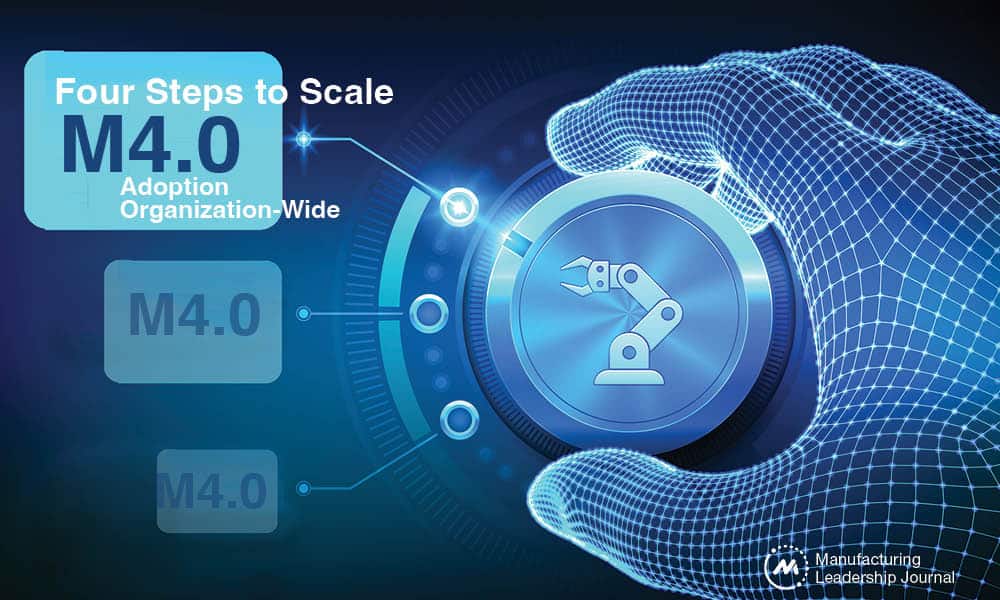
Want to reap Manufacturing 4.0’s benefits at scale? Let this four-step roadmap lead the way.

TAKEAWAYS:
● M4.0 has significant implications for industrial operations, integrating advanced technologies with traditional manufacturing processes.
● Adopting and scaling M4.0 requires an understanding of best-practices to avoid common mistakes and improve outcomes.
● A successful scaling process begins by examining the current and desired future state.
Why follow these steps?
The M4.0 transition is more than just the adoption of new technologies; it is a complete reimagining of design, production, and delivery methodologies. Successfully navigating this transformation requires a well-structured roadmap, a robust maturity model, and an effective transformation framework.
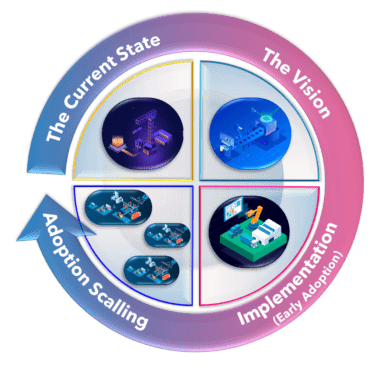 Adopting M4.0 is more nuanced than meets the eye. Following best practices at each phase helps to avoid these common mistakes when scaling M4.0’s adoption:
Adopting M4.0 is more nuanced than meets the eye. Following best practices at each phase helps to avoid these common mistakes when scaling M4.0’s adoption:
- Failing to fully integrate: M4.0 is not just about technological upgrades; it is about how these technologies are integrated into an organizational structure and leadership. Good use cases become great when embedded into a broader, cohesive strategy.
- Overlooking strategy: M4.0 success hinges on a culture of innovation and collaboration. Avoid the mistake of letting promising use cases stall at the pilot stage due to a lack of strategic direction.
- Underestimating the challenges of scaling: Scaling M4.0 solutions across an organization is complex. Ensure new solutions are compatible and synergistic with existing operations.
The Four-Step Approach
1. The Current State
Identifying gaps and opportunities for improvement
In pursuit of continuous growth and excellence, understanding the current state is vital. This process is not just about what we assess, but also about who contributes to this assessment. Insights should be inclusive, coming from all levels within the organization and from external sources.
Begin by asking:
- What are the core competencies? Where are improvements needed?
- Which gaps in operations can turn into growth opportunities?
- How can existing resources and capabilities be used to meet objectives?
These questions will help identify improvement areas and create action plans to address them. Be enthusiastic and proactive in finding the answers collaboratively.
Regarding methodologies, while frameworks like Six Sigma and Design Thinking offer structured routes towards improvement, their effectiveness lies in how they are applied. The ideal approach is one that yields comprehensive feedback, capturing diverse insights from outside and within, addressing various organizational dimensions.
2. The Vision
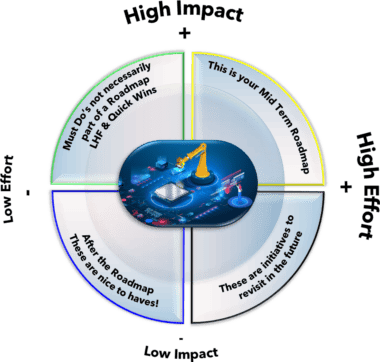
Defining the future state and prioritizing initiatives
Crafting a vision for the future within M4.0’s context requires cross-functional collaboration to establish clear, significant, and practical goals. With these in place, the most impactful and achievable initiatives can begin.
It is important to communicate not only enthusiasm for this vision but also its practicality in fostering innovation, efficiency, and competitiveness.
Here are key elements that align with M4.0’s three pillars of organization, technology and leadership:
From a customer-centric perspective: (Organization)
- Organizations must challenge themselves to think differently, innovate constantly, and deliver value in everything they do.
- The goal is to perceive products and services at their core, recognizing and emphasizing what makes them unique and valuable.
- Aim for products and services to positively transform customers’ experiences, driven by innovation and opportunity rather than constrained by tradition.
From a technology perspective: (Technology)
- Artificial intelligence (AI) and machine learning (ML): AI and ML enable manufacturers to optimize production, reduce costs, enhance quality, and boost customer satisfaction. They also play a role in new product design, demand prediction, and failure prevention.
- Robotic process automation (RPA): RPA allows manufacturers to increase efficiency, productivity, and safety. They complement human labor, performing complex tasks and safely handling hazardous materials.
- Enterprise IoT and cloud computing: These are key in connecting and monitoring our machines, devices, and systems in real-time; improving data collection, analysis, and decision-making capabilities; and facilitating remote access and control.
- 3D printing and additive manufacturing: These allow for the creation of customized, intricate products with reduced waste and costs and faster delivery. They are also essential for prototyping, material testing, and product repairs.
These technologies enable some of the most impactful innovations in modern manufacturing and are integral to a vision roadmaps.
From a C-level perspective: (Leadership)
- Culture and people: To achieve a future where digital solutions elevate human creativity, collaboration, and innovation, roles must transform to enhance capabilities rather than replacing them.
- Technological integration: Technology must become an intrinsic part of an organization’s DNA, enabling it to achieve objectives and revolutionize production and delivery methods.
- The ecosystem and parallel ecosystems: Manufacturers must aim to be leaders, not followers, in the market. Identifying the ecosystem, competitors, and the startup landscape is crucial. They must recognize and respond to market shifts, acknowledging that today’s business environment is interconnected and boundaryless.
3. Implementation and Early Adoption
The right partners with the right technologies for the right processes at the right time
The practical implementation of an M4.0 vision involves introducing disruptive technologies and innovative practices in a way that is both efficient and minimally disruptive to the operation. Implementing these changes is a complex process that necessitates adjustments in organizational culture, business models, processes, and skill sets.
To successfully navigate early adoption, the following is a sequential approach that highlights the interdependence of each step, creating a cohesive path forward:
- The right partners with the right technologies: It is crucial to collaborate with organizations that not only provide the necessary technological solutions but also understand and align with organizational culture and values. This partnership should be marked by agility, adaptability, and a proactive approach to facing challenges and seizing opportunities. After all, building long-term, mutually beneficial business relationships is a competency worth maturing constantly.
- The right technologies for the right process: The key to successful technology implementation is integration. This means creating a cohesive system from disparate elements, ensuring M4.0 solutions are interoperable, compatible, and complementary. While traditional systems like ERP, MES, SCADA, and BMS form part of this, the incorporation of IoT platforms with integrated analytics is essential. Such platforms provide comprehensive insights across all levels of the business.
- The right process at the right time: When selecting processes for early adoption, it is strategic to start with those the organization has mastered and are already mature. However, manufacturers must also consider how external variables, whether from outside the process or external to the company, can skew insights. These external influences can lead to inaccurate analytics, potentially jeopardizing decision-making and business performance. It is important to identify and account for these external variables, ensuring that all insights are thoroughly validated and verified before they are applied to strategic or operational decisions.
4. Adoption scaling
Evaluating and expanding the outcomes
Adoption scaling in Manufacturing 4.0 (M4.0) involves the process of strategically broadening the reach and impact of innovative solutions, transitioning from initial pilot stages to full-scale integration within an organization. Key challenges in this process include technical complexities, regulatory compliance, organizational adaptation and change management, social acceptance, and logistical coordination.
The four primary drivers and enablers of adoption scaling in the manufacturing sector include:
- Customization and personalization demand: The growing need for customized products calls for greater flexibility and agility in production processes.
- Efficiency and productivity pressure: Amidst rising competition and cost pressures, organizations must focus on optimizing resource utilization and minimizing waste to stay ahead.
- Environmental and social responsibility: The rising awareness around sustainable and responsible manufacturing practices compels manufacturers to adopt more eco-friendly and socially responsible methods. This commitment must reflect a company’s core values and resonate with its stakeholders and customers.
- Leveraging Industry 4.0 (I4.0) technologies: The accessibility and affordability of I4.0 technologies provide a unique opportunity for innovation and value creation. By harnessing these technologies, companies can drive transformational changes across our manufacturing landscape. M
About the Author:

Roberto Cisneros is the Director of IIoT Solution Architecture at Softtek
Dialogue: Using Innovation to Complement Workers
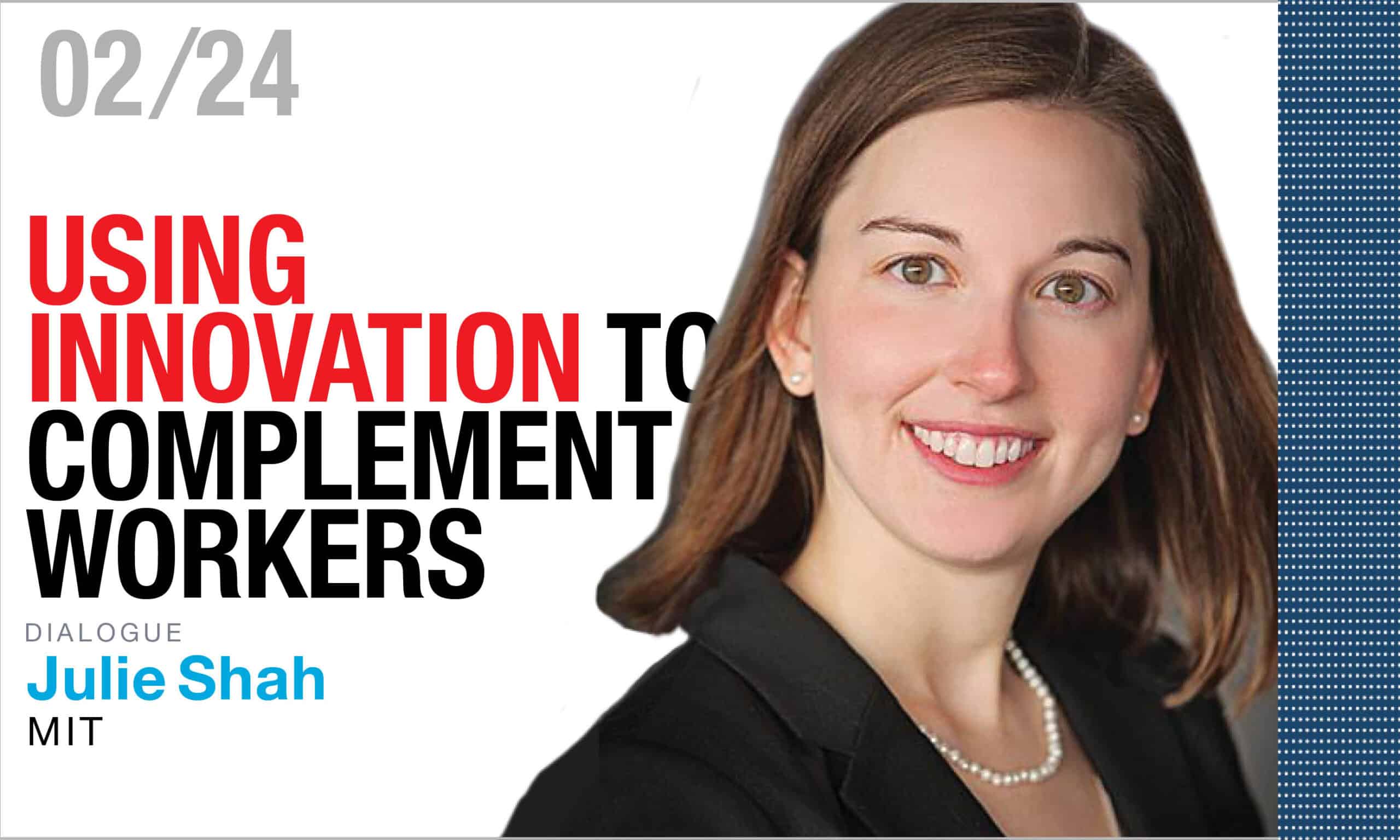
MIT is partnering with Amazon to develop best practices for introducing new technologies alongside quality jobs.

Dr. Julie Shah of the Massachusetts Institute of Technology joined the MLC’s Board of Governors in 2022. Since then, she has participated in MLC’s Rethink and Manufacturing in 2030 events, speaking about the use of AI in manufacturing and its implications for the manufacturing workforce. In October of last year, MIT announced a partnership with Amazon to research how best to use innovative technologies such as AI and robotics to complement rather than replace workers. The Manufacturing Leadership Journal recently sat down with Dr. Shah to discuss her work and the objectives of the partnership with Amazon.
Q: Could you describe your role at MIT and your areas of concentration from a research and teaching perspective?
A: I’m the H.N. Slater Professor in MIT’s Aeronautics and Astronautics department. I also co-lead MIT’s Work of the Future initiative, directing cross-disciplinary research on how innovation impacts jobs. My own AI and robotics lab aims to imagine the future of work by designing collaborative AI teammates that enhance human capability. I partner with companies to translate these ideas into real-world industries — manufacturing, healthcare, transportation, aerospace, and more. At MIT, I teach classes focused on human-centered design of AI, robotics, and autonomous systems. And through cross-campus initiatives like the Work of the Future, we’re engaging policymakers, academics, and industry leaders to shape a more positive future enabled by technology.
Q: You were one of the key people involved with MIT’s Work of the Future initiative, a report on which was published in 2020. Could you summarize some of the key findings of that report?
A: MIT’s former president, Rafael Reif, convened a three-year task force back in 2018 during a time of high anxiety about automation and its potential to displace jobs. Some forecasts predicted that up to half of all jobs were vulnerable. The task force took an interdisciplinary approach to evaluating those claims. What we found was a much more nuanced story — new technologies did not appear to be eliminating jobs outright, but technological progress was also not contributing to widely shared prosperity.

“We want to grow a community that advances automation responsibly and inclusively.”
For example, our researchers found that robots are often inaccessible for small and medium enterprises, which employ nearly half the US manufacturing workforce. This leads to unequal productivity distribution, with large firms able to achieve much higher productivity than smaller ones.
The main takeaway, and the vision for building on the task force’s work, is that we should strive to align innovation with good outcomes for all workers.
Q: Very interesting. Pivoting topics a bit, last fall, MIT and Amazon announced a partnership to fund research into best practices for introducing new technologies alongside quality jobs. What are the goals there and how do you see that effort building on the Work of the Future report?
A: The vision is to shape a future where innovation complements rather than displaces workers. We also want to grow a community advancing automation responsibly and inclusively.
To study this, we recently launched an “Automation Clinic” at MIT where students team up with companies to see firsthand how tech impacts jobs. Over two years we’ve worked with 20+ firms in sizes ranging from 20 to 1,000+ employees. We’re making short docuseries showing real use cases.
Going forward, we’ll expand these learnings through new partnerships across the country. We already have interest from Ohio, Indiana, and Oklahoma. The idea is getting more schools, students, and employers exchanging ideas for “positive-sum” automation that drives productivity but also employee flexibility. Our Amazon collaboration specifically supports grad students to embed directly to study the introduction of new technologies in small and medium firms.

“Our Amazon collaboration specifically supports the study of new technologies in small and medium firms.”
Q: Is there a timeline yet for publications or outcomes from that effort?
A: We plan to publish initial findings as a series of case studies in mid 2024. Longer-term, the goal is to translate insights from the research into educational resources and training materials for broader distribution, both to industry practitioners as well as for engineering education.
Q: Great, look forward to seeing those results. Finally, I understand you also have a working group focused specifically on generative AI. Can you discuss the goals and composition of that effort?
A: MIT’s Work of the Future initiative has convened a cross-disciplinary group of industry and academic leaders to study how the design and use of generative AI tools can enable higher-quality jobs and more inclusive access to the latest technologies.
On the research side, our scholars are already conducting studies analyzing real-world deployment of generative AI systems and their impacts on employees. We’ll be publishing those as academic papers as well as case studies of best practices.
The working group itself just kicked off and meets quarterly to share knowledge and identify guidelines. We’ll also host annual summits for broader discussion among corporate AI leaders. M

FACT FILE: Massachusetts Institute of Technology
Headquarters: Cambridge, MA
Employees: 16, 327
Founded: 1861
EXECUTIVE PROFILE: Dr. Julie Shah
Title: H.N. Slater Professor of Aeronautics and Astronautics at MIT. Leads the Interactive Robotics Group of the Computer Science and Artificial Intelligence Laboratory.
Education: Ph.D from MIT in 2011.
Previous Roles:
– Boeing Research and Technology
About the author:

David R. Brousell is Co-Founder, Vice President, and Executive Director at the NAM’s Manufacturing Leadership Council.
Revolutionizing EV Battery Manufacturing with Data and Smart Factory Technologies
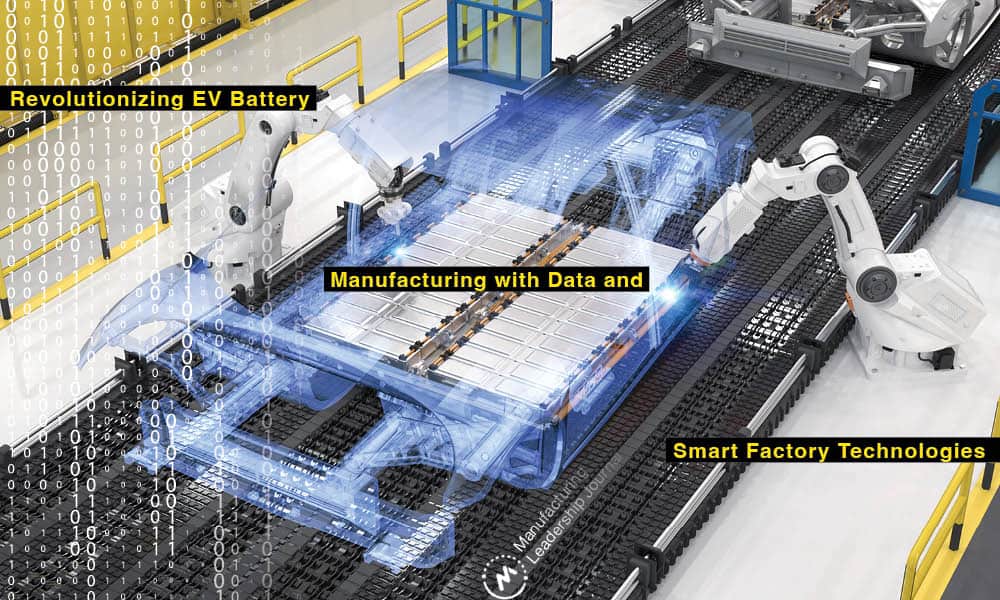
Manufacturers of electric vehicle batteries need to develop a data-driven operating model that is efficient and resilient with room to scale as EVs grow within the automotive industry.

TAKEAWAYS:
● Manufacturing 4.0 principles are informing the strategic direction of EV battery manufacturers, shaping their approach to personnel, digital transformation and supply chain.
● Data will give manufacturers greater understanding of the materials being used, helping them to find ways to innovate and improve efficiency and productivity.
● AI and blockchain technology can give battery manufacturers tools to more quickly adapt when setbacks occur, reducing waste and enhancing quality.
In an era when efficiency and innovation are paramount, the emergence of smart factories has marked a significant shift in manufacturing paradigms. These advanced manufacturing facilities leverage data, automation and technology to create more efficient and adaptable production processes. Central to this evolution is the integration of Manufacturing 4.0 strategies with overarching business objectives.
In the EV battery manufacturing sector, where precision and reliability are critical, leveraging transformative, data-driven technology is pivotal to surmounting business challenges and enhancing performance in battery manufacturing. The M4.0 best practices emerging for battery manufacturers also offer lessons for manufacturing in other sectors and industries.
EV Battery Market Still Evolving
The alignment of M4.0 strategies with business goals is crucial in the battery industry. Battery manufacturers need to explore business model innovation and find ways to drive peak profitability within their core business while simultaneously incubating new revenue streams. They need to not just retain customers, but also capture new ones and deliver an experience that is results-driven, personalized and responsive.
They also need to build resilience in their operating models, leveraging emerging technology to future-proof their supply chains. And EV battery manufacturers must enable talent on multiple levels, making it easier for employees to embrace digitalization and develop new capabilities.
Data-driven approaches underpin this integration, facilitating informed decision-making that streamlines production, improves output, and enhances metrics like yield and ramp-up times. Incorporating deep mineral and component analytics into these strategies allows for a more comprehensive understanding of materials and their impact on EV battery quality, performance and maintenance. This alignment not only boosts operational efficiency, but also fosters innovation in battery design and functionality, crucial for industries like the EV sector, which demands rapid production of high-quality batteries and aims to avoid future liabilities such as recalls.
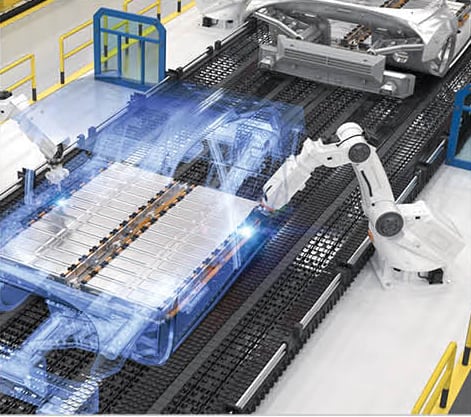
“Battery manufacturers need to not just retain customers, but also capture new ones and deliver an experience that is results-driven, personalized and responsive.”
Regulation and standardization is another element that will shape the EV battery market. It could bring much-needed consistency and structure to a sector that is still seeking broader acceptance from consumers who need confidence that service for EVs will be as accessible and user-friendly as the structure they’ve used for internal combustion engine vehicles. At the same time, regulation and standardization can feel limiting to those with a more innovative approach to business and market growth.
A November 2023 Automotive News article addressed the benefits of such standardization “As standardization is achieved in areas such as connectors, chargers, regulations, and payment integration, OEMs and ecosystem partners will be better equipped to explore innovations that will further improve the customer experience, like contactless charging and seamless, transparent, automatic electricity billing.”¹
The article added that OEMs need to be ready for rapid changes in required battery capacity and vehicle range as the EV market continues to take shape.
Digital Transformation Requires Persistence
Digital integration is key in modernizing battery manufacturing processes and it can often be challenging. Companies need to determine where to start, how to scale and how to accelerate their efforts. Infrastructure, disparate systems, repeatability and commercial complexity are just a few trends that can impede digital transformation. It can also take time to break down silos and fully convey the value of the transformation. Manufacturers able to maintain focus, work through challenges and continue moving forward should begin to realize the value of their commitment.
Technologies like IoT and AI create a connected manufacturing environment, enabling manufacturers to monitor every aspect of the production line in real time. This extensive data collection and analysis leads to optimized operations, reduced waste and enhanced product quality. It enables manufacturers to create more agile, flexible and resilient processes that can help them better weather disruption – whether they can see it coming or not. Data provides tools to make those real-time assessments, evaluating a company’s current state, as well as its risks and opportunities, to inform decision-making for the next steps.
Specific technology deployment in battery manufacturing addresses challenges such as maintaining consistent quality and maximizing yield. AI algorithms predict equipment failures and identify potential quality issues in battery mixtures, reducing downtime and enhancing energy efficiency. Advanced analytics identify patterns in production data, leading to insights that drive process improvements. These interventions not only solve existing problems, but also enhance performance, leading to higher quality batteries and increased production rates.

“The implementation of autonomous robots and digital twins in manufacturing processes underscores the transformative impact of hybrid human-machine operations.”
A good example of these advances is found in electrode coating. By utilizing advanced sensors for real-time measurements of thickness and density, manufacturers can significantly enhance the quality of battery cells prior to the aging process. This ensures uniformity and optimal material composition, thus reducing the likelihood of defects post-aging. Additionally, in sample cell testing, the use of advanced analytics combined with holistic approaches and traceability — such as blockchain technology — enables manufacturers to identify suboptimal cells early in the process and avoid producing large quantities of suboptimal battery cells.
Moreover, the integration of this sensor data with ERP and MES systems creates a rich, multi-dimensional data landscape. This synergy enhances decision-making and operational agility, showcasing the essence of M4.0 in modern manufacturing.
In practice, battery manufacturers are leveraging these technologies in various ways. For instance, the implementation of autonomous robots and digital twins in manufacturing processes underscores the transformative impact of hybrid human-machine operations. These innovations enhance precision, efficiency, and adaptability, further revolutionizing the battery manufacturing sector.
Summary
The integration of M4.0 technologies in battery manufacturing is a gateway to the future of industrial production. As these technologies evolve, their potential to revolutionize battery manufacturing grows. We can anticipate advancements in collaborative robotics, enhanced digital twin capabilities, and sophisticated AI-driven analytics, contributing to smarter, more efficient, and sustainable battery production.
In summary, the integration of data-driven smart factory technologies in battery manufacturing is a game-changer. By embracing these advancements, manufacturers can overcome traditional challenges, improve operational efficiency, and set new benchmarks in quality and innovation. The future of battery manufacturing is bright, and it is undeniably powered by data.
About the author:

Felipe Smolka is Americas Automotive eMobility Leader at EY
The views reflected in this article are the views of the author(s) and do not necessarily reflect the views of Ernst & Young LLP or other members of the global EY organization.
How Digital Twin Applications Can Help Manage and Optimize Inventory
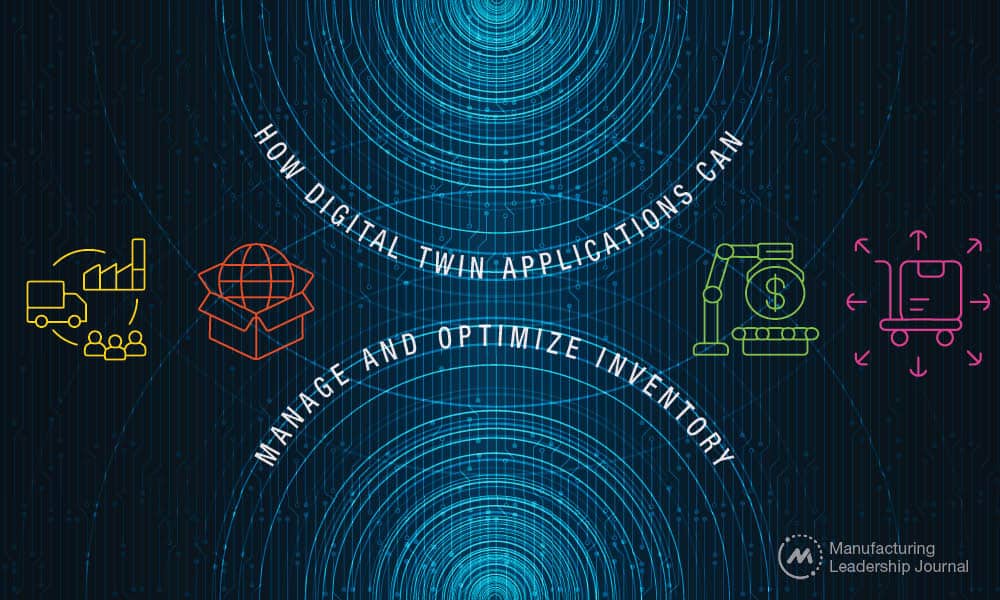
This case study shows how one manufacturer used simulations to evaluate processes and potential equipment investments.

TAKEAWAYS:
● Manufacturers can use digital twins to conduct real-time analyses of processes or operations to predict future performance.
● Running simulation scenarios helped an industrial food production company address bottlenecks and avoid spending millions on new tanks.
● Models created using digital twins can be easily modified to evaluate new operating scenarios in the future.
Plenty of manufacturers use scenario modeling to forecast how their inventory needs may ebb and flow as supply and demand shift. But for organizations that want to enhance the precision of such forecasts, digital twin technology can take things a step further.
Digital twins—essentially virtual representations or simulations of physical operations—allow manufacturers to see how a process or operation performs in real time and predict how it may perform in the future. This type of simulation will increasingly become table stakes in the smart factories of the future.
One RSM client, a midsize industrial food production company, used digital twins to optimize its bulk inventory management capabilities and ultimately determine which investments in personnel, storage tanks, and other supporting storage capacity were necessary. Through simulation, the business was able to re-focus investments on areas of the business that would yield more value. We explore the factors at play in putting this transformative technology into action.
Determining Future Capacity
At the outset of the project, the industrial food production company had numerous priorities: making operations as efficient as possible, improving business processes, and reducing operating expenses while also prioritizing capital investment. To achieve those objectives, the company had purchased production line equipment that would enable it to produce a greater volume of product, but it needed to understand the upstream implications before increasing capacity.

“In running a simulation that accounted for more staff, the scenario met the target sales goal, effectively reducing guesswork of how the business might need to augment staff to accommodate growth.”
That’s where a simulation analysis proved helpful. The company fed operational data into a digital twin model and ran various simulations to understand what the appropriate size of production equipment would be needed to meet the production line demands. Solving that question had many variables, including product mixes, batch sizes, upstream processes’ capacity, new and existing equipment, and plans for future growth.
The main challenge was to determine whether the future-state production system could meet the company’s sales goal of producing an additional 9.5 million pounds of product per year, and how to make sure the organization understood the broader change and impact that growth would have on operations.
RSM’s engagement with the company involved a three-phase approach using digital twins to address that challenge:
1. Discovery phase
- Document simulation questions, assumptions, and model scope
- Collect existing process performance data and/or plan operations studies
- Document, review, and approve on-paper model of in-scope processes and future-state scenarios
2. Analysis phase
- Conduct process studies and finalize model inputs
- Build simulation model of existing system
- Validate simulation model against current performance
- Finalize future-state scenarios
3. Scenarios and impact phase
- Modify model to reflect future-state scenarios and answer simulation questions
- Summarize scenario findings into a final deliverable concluding with a readout for executives and other key stakeholders
Through the simulation process, the company determined that it would need to implement additional production shifts beyond its existing staffing plan to meet anticipated demand. In running a simulation that accounted for more staff, the scenario met the target sales goal, effectively reducing guesswork of how the business might need to augment staff to accommodate growth. The company was also able to determine that additional storage tanks effectively provided no additional production capacity.
With these insights, the company decided to focus on adding equipment at the upstream process before purchasing any new tanks. Running simulation scenarios prevented spending millions on new tanks and focused the company on addressing the bottleneck process.

“The foundational importance of digital twin simulations lies in the fact that they can help businesses transform data-driven insights into real-world decisions.”
Key Benefits
Understanding specific inventory and staff levels is just one aspect of the use case for digital twin simulations. This technology also helps organizations understand the design and layout needs of their warehouse and production facilities and improve stakeholder understanding of impending changes by using 3D representations to explain the change and supporting rationale.
The simulation’s flexible model and dynamic scenario levers enabled the company to experiment with real-world variability that showed the range of expected performance across multiple simulation runs. Models are an enduring asset, and easily modified to evaluate new operating scenarios in the future.
Other key benefits included
- Apples-to-apples comparisons of key performance measures across alternative scenarios versus current state
- Simulations that are easily modified for future projects
- Mitigation of uncertainty and risk of initial plan allowing the client to pivot before missing customer commitments
- Identification of additional process improvement opportunities with upside of an additional 1 million pounds in annual production
From Insights to Decisions
The foundational importance of digital twin simulations lies in the fact that they can help businesses transform data-driven insights into real-world decisions. For many manufacturers, this capability will be paramount as economic and margin pressures require many companies to shift from a “grow-at-all-costs” strategy to focusing on profitability.
Businesses should investigate how digital twins might help them optimize operations through evaluation of multiple potential scenarios, including1
- Diversifying and optimizing product offerings with a focus on high-margin products
- Focusing on production efficiencies across the entire value chain, with continued investment in automation and productivity-boosting technologies
- Renegotiating contracts with suppliers and working with customers to negotiate cost reimbursements
- Streamlining processes and upskilling employees to improve efficiencies
All of this can ultimately help organizations better understand where to focus their investments and adapt operations as needed. M
About the authors:

Casey Chapman is a principal at RSM US LLP.

Joe Krause is a supervisor at RSM US LLP.
1 This paragraph originally appeared in the RSM US article “Margin pressure requires shift from grow-at-all-costs to profitability.”
The MLC Elects New Chair, Vice Chair and Two Leading Industry Figures to its Board of Governors
The Manufacturing Leadership Council (MLC), the digital transformation arm of the National Association of Manufacturers (NAM), has announced the election of new leadership for the MLC Board of Governors for 2024. Additionally, two leading figures from industry have been elected to join the Board. The MLC is the nation’s foremost executive leadership organization dedicated to helping manufacturing companies transition to the digital model of manufacturing by focusing on the technological, organizational, and leadership dimensions of change.
Two long-serving board members have assumed new leadership roles. Dan Dwight has been elected as the MLC Board of Governors Chair. Dwight is President and CEO of Cooley Group and a member of the NAM Executive Committee and Board of Directors. Meanwhile, the new Vice Chair is Ron Castro, Vice President and Chief Supply Chain Officer at IBM Corporation.
Joining as new members of the Board of Governors are Dan Dralle, Executive Director US Government Affairs and Global CIP at Nexteer Automotive, and Larry Megan, Head of Digital at Baldwin Richardson Foods.
“We are very fortunate to have Dan Dralle and Larry Megan join the MLC Board of Governors,” said David R. Brousell, MLC’s Founder, Vice President and Executive Director. “Under Dan Dwight and Ron Castro’s leadership, the Board will vigorously pursue its mission of keeping MLC in the forefront of Manufacturing 4.0 leadership with renewed commitment and energy.”
As an advisory body, the MLC Board of Governors provides guidance to the MLC on its Critical Issues agenda, research studies, and its programs and services for the MLC membership.
“The MLC is leading the manufacturing digital transformation charge,” said Dan Dwight, new Chair. “The Board of Governors keeps its finger on the pulse on what’s happening in factories and connects the dots to technology partners and academia so MLC members can forge a path to a more resilient future for manufacturing.”
With these appointments, the MLC Board of Governors now consists of 18 industry thought leaders who represent the full spectrum of industries and functional roles including large global enterprises, small and medium-sized manufacturers, leading academic institutions and a full array of areas of expertise.
Board members whose terms expired or who have retired include immediate past Board Chair Mike Packer, Eric Fidoten, Brad Heath, Krishna Srinivasan, and Bart Talloen.
Crystal Ball: Business Resilience in 2030 and the Digital Dexterity Effect
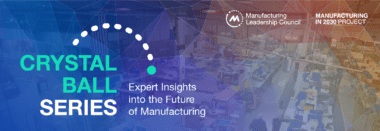
Digital transformation is today’s tested and proven path to business resilience. We help manufacturers digitally transform to strengthen their resilience every day. But our era is defined less by permanence than by alacrity of adaptation. Manufacturers must already evolve their approach to business resilience to remain competitive.
Granted, the need for this evolution is neither intuitive nor obvious. And in fairness, resilient manufacturing enterprises in 2030 will look much like such enterprises do today. But the means for achieving and sustaining resilience by decade’s end will be radically different. Here’s why, and how to prepare for it.
Why business resilience will be different in 2030
Resilience describes a business’s ability to adapt to change effectively and efficiently. For many reasons, data-driven manufacturers are indeed able to adapt well. That’s why businesses that aren’t already data-driven are becoming so.
But digital transformation is a continuum. And few companies believe they have done all they need to do in their transformation. Most recognize that they are in the early or intermediate stages of digital transformation. That will change.
By 2030, businesses that lead their industry will have passed beyond the stages of digital transformation. The businesses will have entered a state of digital dexterity. In that state, business resilience manifests in sharply different ways than it does today.
How business resilience will be different in 2030
Business resilience based on digital dexterity has many facets. Among them, three stand out as being potentially unexpected. First, high-level objectives will remain vital to defining initiatives aimed at strengthening business resilience. But those objectives will not be the exclusive driver. Digitally dexterous manufacturers will employ a fluid governance model. This reflects the future reality wherein company-wide resilience initiatives will emerge from diverse organizational levels, and not always from the top.
A second difference in the way business resilience will manifest lies with the workforce. Digital dexterity means making sure that the workforce has access to, and understands how to use, your business’s data and technologies. Employees will have the information they need to understand how changing their own workflows could have wide-reaching benefits. They will be able to see ways to boost resilience from their specific position. These will be ways not obvious from a top-down view.
In fact, the top-down view will itself be different, which is the third key facet we are considering. Digital dexterity will mean that all executives – not just those in IT – feel at home with technology. In the same way that an executive today can assess how well one staff member is performing, they will be able to assess how well a technology is performing. For example, is a particular AI algorithm doing what it should, and is it enabling the desired business resilience outcomes? That level of digital literacy will be a basic requirement for leaders in digitally dexterous companies.
What you can do now to prepare for the future of business resilience
We’ve called out ways of enabling business resilience in the future that will be strikingly different. Preparing for those differences will set you on the right path. A cultural awareness and acceptance of shared responsibility for business resilience takes time to develop. But it also follows naturally as your workforce evolves on the path to digital dexterity. The key here is to ensure that everyone in your organization has the opportunity to participate in the digitization of their roles. Organizational change management will be instrumental in this workforce development.
Establishing a higher baseline of digital literacy among your leadership team takes time as well, and you’ll need to begin soon. Leaders must be able to evaluate technologies for their effectiveness as intuitively as they do employees, but that is predicated on educating and training leaders with the requisite skills. Ideally, upskilling and reskilling should always remain slightly ahead of technological change.
Business resilience in 2030 will be decentralized and deeply integrated in the manufacturing enterprises’ people, processes and technologies. It will be the inevitable outcome of your organization’s digital dexterity.
To learn more, please visit NTT DATA’s manufacturing page.
About the Author
 Siva Gurupackiam is Senior Vice President of Manufacturing Industry Solutions at NTT DATA.
Siva Gurupackiam is Senior Vice President of Manufacturing Industry Solutions at NTT DATA.
Creating an M2030-Ready Organization by Embracing Generational Divides
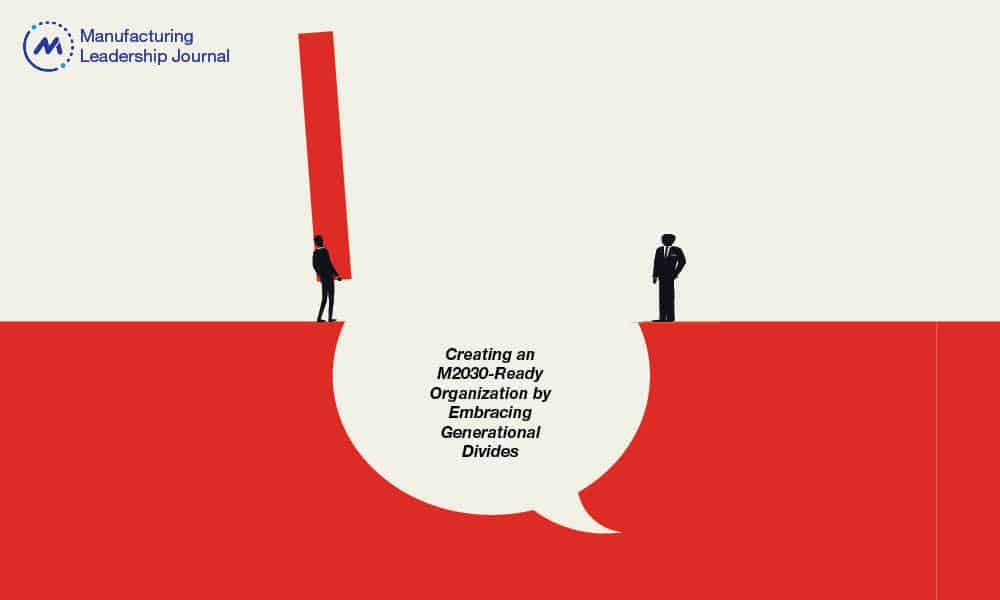
Leveraging the strengths and understand the needs of each generation in the workforce can promote organizational resilience.

TAKEAWAYS:
● Learn how to evolve your leadership, organization, culture, and people to lead your organization to be future-fit.
● Learn how to turn the generational gap into an opportunity by leveraging the unique perspectives, skills, experiences, and preferences of each generation and fostering a culture of knowledge sharing.
● Build coaching tribes that utilize mentoring and reverse mentoring to speed up the training of your younger generations, who will soon make up the largest portion of your workforce, while leveraging the unique experience of the other generations in your workforce.
To successfully implement Manufacturing 4.0, industrial organizations must prioritize leadership, organization, culture, and people. This will enable them to build a strong foundation for adopting new technologies and processes to drive long-term growth and success.
Adopting a collaborative, cross-functional approach involving all stakeholders — employees, suppliers, and customers — requires breaking down traditional organizational silos and fostering a culture of openness, transparency, and continuous learning.
One key strategy for implementing collaborative, cross-functional structures is to establish multidisciplinary teams that bring together individuals with diverse skill sets and backgrounds. These teams should identify opportunities for improvement and develop solutions that leverage advanced technologies.
A clear vision for transformation, easy-to-understand communication of the benefits and goals of the initiative, along with training and development programs are critical change management strategies for the successful implementation of Manufacturing 4.0. Employees need the skills and knowledge to work effectively as the environment around them changes.
To ensure that the change is sustained over the long term, it’s important to use metrics to measure the success of the initiative and to continuously monitor and refine processes. Regular feedback and input from employees, customers, and other stakeholders can contribute to resiliency as market conditions change and technology advances.

“One key strategy for implementing collaborative, cross-functional structures is to establish multidisciplinary teams that bring together individuals with diverse skill sets and backgrounds.”
Creating a culture of innovation and continuous improvement can be achieved through incentivizing employees to share ideas and contribute to process improvements. Regular feedback and recognition can also encourage employees to embrace new ways of working and adopt a continuous improvement mindset.
Finally, partnerships with external stakeholders such as suppliers, customers, and industry organizations can drive innovation and collaboration within the manufacturing ecosystem, accelerating the adoption of new technologies and processes and driving overall industry growth.
Here are the lessons we’ve learned on the crucial facets to becoming a future-fit organization:
Leadership:
● Establish a clear vision and strategy for Manufacturing 4.0.
● Show top-down commitment to digital transformation and innovation.
● Communicate effectively and manage stakeholders.
● Possess strong change management skills and lead through change.
● Inspire and guide the organization through the transformation process.
● Embrace change, promote a culture of innovation, and communicate the vision and goals of Manufacturing 4.0 to all stakeholders.
Organization:
● Structure the organization to facilitate collaboration, cross-functional integration, and agile decision-making.
● Form collaborative cross-functional teams that allow for the seamless flow of information and resources.
● Implement flexible work arrangements and adopt Agile methodologies.
● Define clear roles and responsibilities to ensure accountability and alignment across teams.
● Establish robust project management processes to ensure effective execution of initiatives.
Culture:
● Cultivate a culture of innovation and continuous improvement that encourages experimentation and risk-taking.
● Emphasize data-driven decision making.
● Empower employees to make decisions and take ownership of their work.
● Promote collaboration, teamwork, and knowledge sharing.
● Develop a customer-centric culture.
● Encourage experimentation, provide tools and resources to innovate, and recognize and reward employee contributions.
People:
● Recruit individuals with the right mindset and attitude to drive innovation and change.
● Invest in training and development to ensure employees have necessary skills to operate in a digital environment.
● Promote a culture of learning and development.
● Emphasize diversity and inclusion to promote a creative and inclusive work environment.
● Recognize and reward employees who contribute to Manufacturing 4.0 initiatives’ success.
The challenge of workforce generations today
The four generations currently represented in the workforce each have unique values and expectations that shape their attitudes and behaviors in the workplace. Building organizational resilience requires understanding and leveraging the strengths of each generation.
Baby Boomers value stability and security, and many are approaching retirement age. They have a wealth of knowledge and expertise that can be leveraged through mentorship and knowledge transfer programs to build organizational resilience.
Generation X is characterized as being independent, adaptable, and tech-savvy, and they value work-life balance and career growth. To build resilience, organizations can invest in training and development programs, offer flexible work arrangements, and create career advancement opportunities.

“Organizations are shifting toward career paths that prioritize gaining experiences and skills, allowing employees to move between different parts of the organization where they can best apply them.”
Millennials are the largest generation in the workforce and are known for being entrepreneurial, collaborative, and socially conscious. They value purpose-driven work and expect a work environment that aligns with their personal values. To appeal to this group, organizations can create a purpose-driven culture, prioritize diversity and inclusion initiatives, and offer opportunities for collaboration and innovation.
Generation Z is just entering the workforce and is known for being entrepreneurial, tech-savvy, and adaptable. They value flexibility, work-life balance, and are comfortable with remote work arrangements. To build resilience, organizations can offer a flexible and technologically advanced work environment that leverages their digital skills and supports their desire for work-life balance.
To develop a framework that considers the unique characteristics and preferences of each generation, organizations can follow some key steps:
Develop a culture of respect and inclusion: Ensure that all generations are respected and valued, regardless of age or experience. Encourage communication and collaboration between generations, create a culture that embraces diversity and inclusion, and foster transparency. This improves feedback and ensures that everyone feels comfortable sharing their opinions.
Foster knowledge transfer: Develop programs that transfer knowledge and expertise from older generations to younger ones. Encourage intergenerational teams to work together on projects and initiatives through mentorship, reverse mentorship, and job shadowing opportunities.
- Provide training and development opportunities: Invest in programs that cater to the learning styles of each generation to upskill and reskill workers across all generations, using both e-learning platforms and in-person training. This will ensure that all employees have the skills needed to succeed in their current roles and in the future
- Offer flexible work arrangements: Older workers may value stability and traditional work arrangements, while younger workers may value work-life balance and flexibility. Offering flexible work arrangements such as remote work or flexible schedules can help meet the needs of all generations.

“To leverage each generation’s preferences, it’s important to identify each employee’s generation, target group within the organization, and level of training expertise.”
Leverage technology to bridge the gap between generations and facilitate communication and collaboration: Utilize social media platforms, video conferencing, and collaboration tools that allow employees to work together regardless of location or generation.
Putting it all together: Building Coaching Tribes
Today, traditional career paths are often focused on specific job titles (i.e., project manager, supply chain planner, logistic execution analyst) within functional silos. However, new organizations are shifting toward career paths that prioritize gaining experiences and skills, allowing employees to move between different parts of the organization where they can best apply them.
To leverage each generation’s preferences, it’s important to identify each employee’s generation, target group within the organization, and level of training expertise. By doing so, organizations can choose the appropriate learning methods and content to effectively train and develop their employees.
Since companies today are made up of individuals from different generations, each with their own unique skills and expectations, this diversity creates a “tribal” culture where different groups require different experiences. Therefore, we propose a reciprocal coaching environment where generations can learn from one another. More experienced members can share their seniority and knowledge, while younger members can contribute their understanding of new digital technologies and their innovative approach to work. This collaborative effort will help create a more productive and connected workplace culture. M
About the author:

Jose “Pepe” Tam is Digital Transformation Vice President at Softtek.
Dialogue: A Future of Data-Driven Leadership

With expertise in data science, Dow’s Amanda Ahrens has a unique understanding into what the power of data can mean for the future of manufacturing and its role within R&D, sustainability, asset optimization and more.

Last June, Amanda Ahrens of Dow was honored at the Manufacturing Leadership Awards as the winner of the Next-Generation Leadership category, which is given to a high-performing emerging leader aged 30 or younger. Her background in mathematics and data science is emblematic of the emerging role of data analytics in manufacturing – a true embodiment of the industry’s future.
Ahrens has experience with both corporate IT and R&D during her time at Dow, an unusual and challenging career path but one that gives her unique insight into different areas of the business. She is also a strong advocate for promoting STEM career for women and minorities, serving as a volunteer for the Michigan Council of Women in Technology, computer science coordinator for Dow’s Girls in STEM program, and a coordinator and lecturer for an introductory data science programs for HBCU undergraduates. In this interview, she discusses data’s growing role in manufacturing, how it can provide fuel for ESG initiatives, and what she thinks are the most exciting use cases for AI.
Q: Data science has a growing and important role in manufacturing. How do you see that role evolving in the next 3-5 years?
A: It is becoming easier to access data to build models, deploy models, and maintain models. Data quality, however, has always been and continues to be a barrier to building models that provide useful results. As manufacturers see a return on investment regarding data science, if reinvested to maintain high-quality data (by sharing the results with data owners, investing in soft sensors and AI enhanced sensors, investing in systems fit for purpose that enable fast and easy data cleansing and analysis), other use cases will be unlocked. AI and data science is best when people don’t even realize it is there and will need to be embedded into modern processes and tools to realize the full value cases.
Q: You started at Dow as part of the corporate IT team before making the switch to R&D. What was that transition like for you, and how does data analytics play a role in R&D?
A: My internal clients were completely different in corporate IT, R&D, and Manufacturing regarding what data they regularly worked with, how they used data, and how they wanted to receive data and data analysis. During my transition, I learned about my new client personas. In R&D, data analysis is used to design experiments, analyze lab test results, identify product portfolio gaps for new product opportunities, predict formulations to deliver desired properties, and many other use cases. The data in R&D is very wide, meaning that there are fewer rows (or samples) than columns (chemical structure, properties, applications testing results). Wide data requires data analysis techniques that are meant for this type of data.

“AI and data science is best when people don’t even realize it is there and will need to be embedded into modern processes and tools to realize the full value cases.”
Q: Your role has evolved to include ESG initiatives, working toward the goal of reducing Dow’s carbon emissions. How can manufacturers use data to further their sustainability goals?
A: Having granular, frequent, and accurate data on direct air, waste, and water emissions as well as energy consumption allows for prioritization of capital investment for sustainability initiatives. Tracking raw materials or feedstock with sustainability attributes through procurement, production, material movements, and product sale in a streamlined way enables tracking for product certification and scale to progress on both circular economy and climate goals. Data from suppliers can help you strategically source to lower Scope 2 and Scope 3 emissions and purchase energy, feedstock, and raw materials with sustainability attributes in alignment to your sustainability goals. Data from customers can help you understand your downstream Scope 3 emissions, develop products that better meet their needs and their sustainability goals, and progress on your sustainability goals in the process. The few examples above illustrate that data from your own operations, suppliers, and customers is foundational to decision-making to advance sustainability goals.
Q: It was noted in your awards nomination that you are one of the leaders for Dow’s annual Data Science Challenge. Can you describe that program?
A: Dow has a biannual Data Science Challenge, and I co-led the 2022 Data Science Challenge. Each challenge is run in a shark-tank like format where cross-functional and cross-business teams pitch their data science idea to a panel of Dow executives (sharks). The winning project ideas are then invested in. In 2022, the theme was advancing Dow’s sustainability goals regarding climate, circular materials, and safer materials. The winning idea and other challenge ideas have been incorporated into our digital strategy.

“Girls who are exposed to women in manufacturing will grow up knowing that it is a possibility for them. Women seeing women thriving in manufacturing will attract more to the industry.”
Q: You also have experience with testing AI use cases for Dow. While a number of manufacturers are using AI for quality and preventative/predictive maintenance, what are some emerging use cases that you think have potential for greater impact?
A: A lot of data is unstructured (text) and stored in various systems, emails, PDFs, Word files, Power Point slides, etc. With large language models, like ChatGPT, we can make better use of this collective knowledge to answer procedure questions faster. Soft sensors and sensors that are enhanced or augmented with AI will enable us to gather data that used to be more costly to gather with traditional instrumentation and metering. Having more granular data on emissions, water, and energy from these types of sensors enables optimization of manufacturing processes further regarding energy efficiency, emissions, water conservation, etc., with the use of AI, in addition to optimizing asset utilization. AI could also be used to aid in shut down and start up activities.
Q: Women tend to be underrepresented in STEM fields, and they make up less than 30% of the manufacturing workforce. What changes need to take place to bring more women into the industry?
A: Girls who are exposed to women in manufacturing will grow up knowing that it is a possibility for them. Women and male allies being in the classrooms sharing the exciting scientific and engineering feats that are accomplished in manufacturing will inspire girls to become women in manufacturing. Providing employees time to volunteer and sponsoring events to expose girls to STEM is important for developing the pipeline. Then, once the women are in manufacturing, invest in keeping them there. Ensure women have both women and men on their board of sponsors and mentors. Provide an avenue for employees to attain reliable childcare and senior care for their family members. This would greatly benefit women since they are often primary caretakers, especially for employees that do not have an 8-5 work schedule as finding care outside of the typical work week is even more difficult. Women seeing women thriving in manufacturing will attract more to the industry. M

FACT FILE: Dow
Headquarters: Midland, Michigan
Industry Sector: Chemicals
Annual Revenue (2022): $56.9 billion
Employees (2022): 37,800
Production: 106 sites in 31 countries
EXECUTIVE PROFILE: Amanda Ahrens
Title: Sustainability Data Architect – Enterprise Architecture (Houston, TX), 2021 to present
Education: Michigan State University, B.S., Mathematics; Texas A&M University, M.S., Analytics
Previous Roles:
– Data Visualization Specialist – Advanced Analytics (Midland, MI), Dow
– Research Informatics Analyst – R&D Information Research (Midland, MI), Dow
– Data Scientist – Digital Operations Center (Houston, TX), Dow
About the author:

Penelope Brown is Senior Content Director of the NAM’s Manufacturing Leadership Council.
Placing Innovation at the Heart of Transformation

To build the right foundation for long-term growth, manufacturers must put innovation and digital strategies at the heart of transformation.

TAKEAWAYS:
● Massive geopolitical, technological and cultural changes have prompted unprecedented shifts in industrial manufacturing.
● As pressures mount to build smart products, digitize operations and exceed customer expectations, incremental approaches to change are falling short.
● Manufacturers need to design a transformation that is innovative, agile, cross-functional, and scalable to realize tangible business value.
Over the last several years, challenges related to geopolitics, technology, the pandemic and climate change have shaken the foundation of industrial manufacturing – creating tectonic shifts in how manufacturers think, operate and deliver their products and services.
The pressure to make products smart and connected, digitize the factory and operations, create more automated and reliable supply chains, and deliver on rising customer expectations presents significant opportunities to move toward radical growth. Yet many manufacturers’ current approaches – driven by siloed teams, functions rather than strategies, and static views of competitive and operational landscapes – present significant risks on the road to reinvention.
Legacy manufacturers trying to speed ahead into the future of smart products, digital platforms and new service-oriented business models urgently need a better way forward. A hybrid, innovation-led approach that incubates future businesses while simultaneously optimizing today’s products and operations can provide practical, value-driven solutions in both the short and long term.
Disruptive Forces Shift Operational Priorities
The range of disruptive forces manufacturers are experiencing has implications across the entire enterprise. These forces include:
- sector convergence
- power shifts within value chains
- evolving customer expectations
- volatile macroeconomic environments
- tougher workforce dynamics
- sustainability pressures
- transformative technologies
In response, manufacturers are prioritizing digital transformation and innovation-related investments. According to the EY January 2023 CEO Outlook Pulse survey, virtually all (97%) of industrial manufacturing CEOs indicated that continuing digital and technology transformation to deliver growth and operational advantages is either a very or fairly important near-term priority, despite near-term economic uncertainty.
Through these investments, manufacturers seek to revolutionize processes by implementing innovations such as digital twins, artificial intelligence and machine learning. At the same time, they are advancing product and service offerings across the value chain that are smart and connected.
However, to fully realize the significant opportunities arising from disruption and the value of these investments, manufacturers must tie them to a unifying vision of where their markets are headed.

“Legacy manufacturers trying to speed ahead into the future of smart products, digital platforms and new service-oriented business models urgently need a better way forward”
A Different, Innovation-Focused Approach to Manufacturing Transformation
Forging a new path to the future will require manufacturers to put their growth agenda at the center of transformation. This plan needs to be backed by a detailed strategic roadmap that accounts for both the innovations needed to succeed and the transformation required to launch and scale these breakthroughs in the market. It must also be developed with an enterprise-wide outcome in mind, breaking down functional and geographic silos.
While not every initiative needs extensive cross-organizational coordination and buy-in, many of the most prominent areas for manufacturers’ business reinvention are inherently interdisciplinary. Effective transformations demand engagement with a range of intersecting value drivers, including product and service innovation; customer experience; intelligent and sustainable supply chains; workforce and talent; and business model innovation.
Image 1: The value drivers of tomorrow
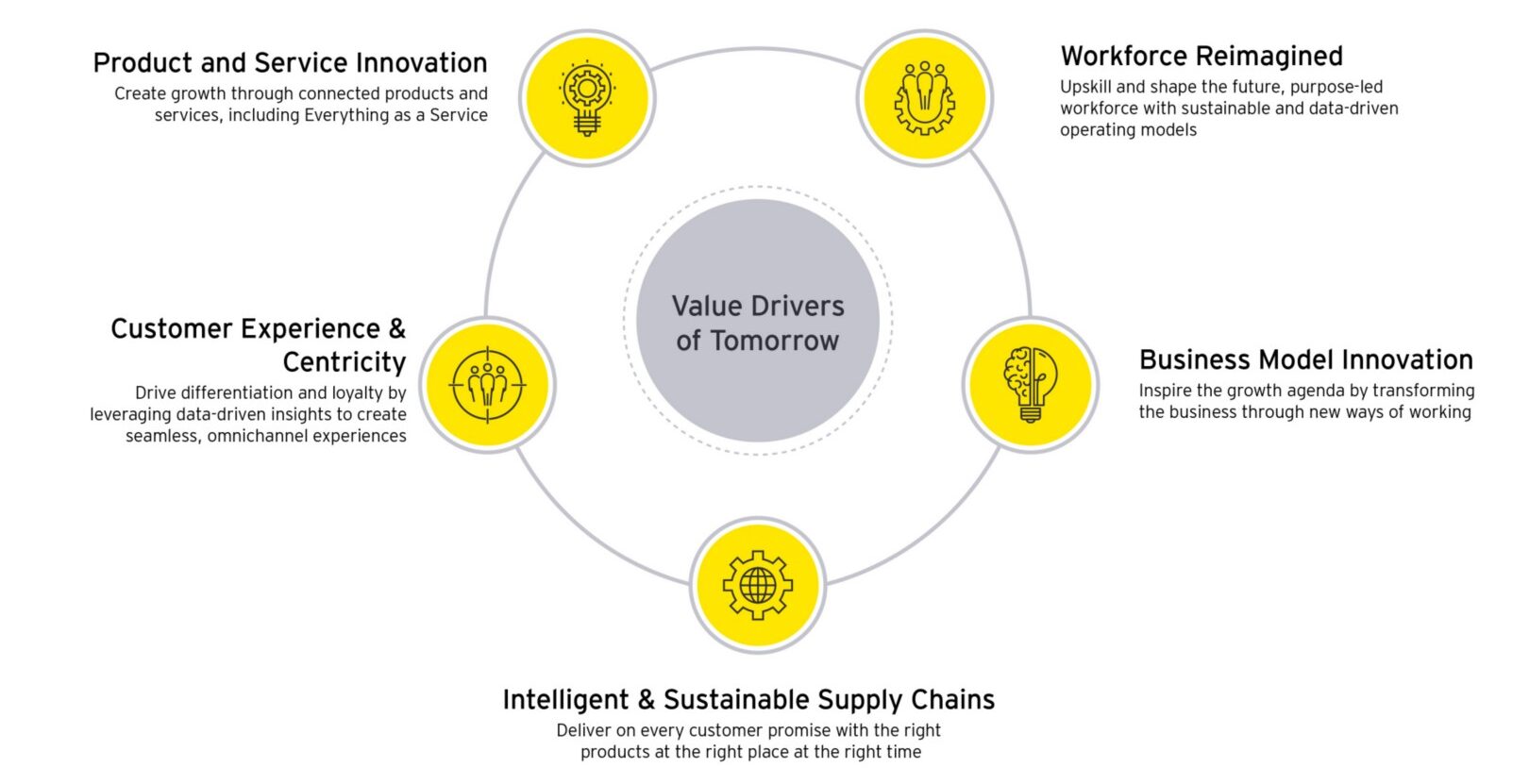
Image 1: A chart showing the value drivers of tomorrow that intersect include product and service innovation; customer experience; intelligent and sustainable supply chains; workforce and talent; and business model innovation. Source: EY
Once a decision is made to pursue small- or large-scale reinvention, manufacturers can maximize the speed, agility and long-term value generation by adopting the following best practices.
Start With the End in Mind But Also Know Where to Begin
With business challenges clearly defined, manufacturers should explore solutions using a future-back approach that starts with the end in mind. The critical first step involves rapidly defining and assessing tomorrow’s potential futures from the outside-in, and predicting how these future scenarios may shape customer needs, market conditions and value pools across time horizons. In parallel, organizations must also perform a thorough review of their current capabilities, particularly those that may play an increasingly important role in future competitiveness.
Taken together, assessments of a company’s current state and potential futures serve as the foundation of a new strategy that will act as the transformation’s North Star – guiding it relative to the level of ambition, while optimizing development speed and investment spending. This strategy should also provide a framework for cross-enterprise transparency and engagement.
Image 2: Our approach to transformation
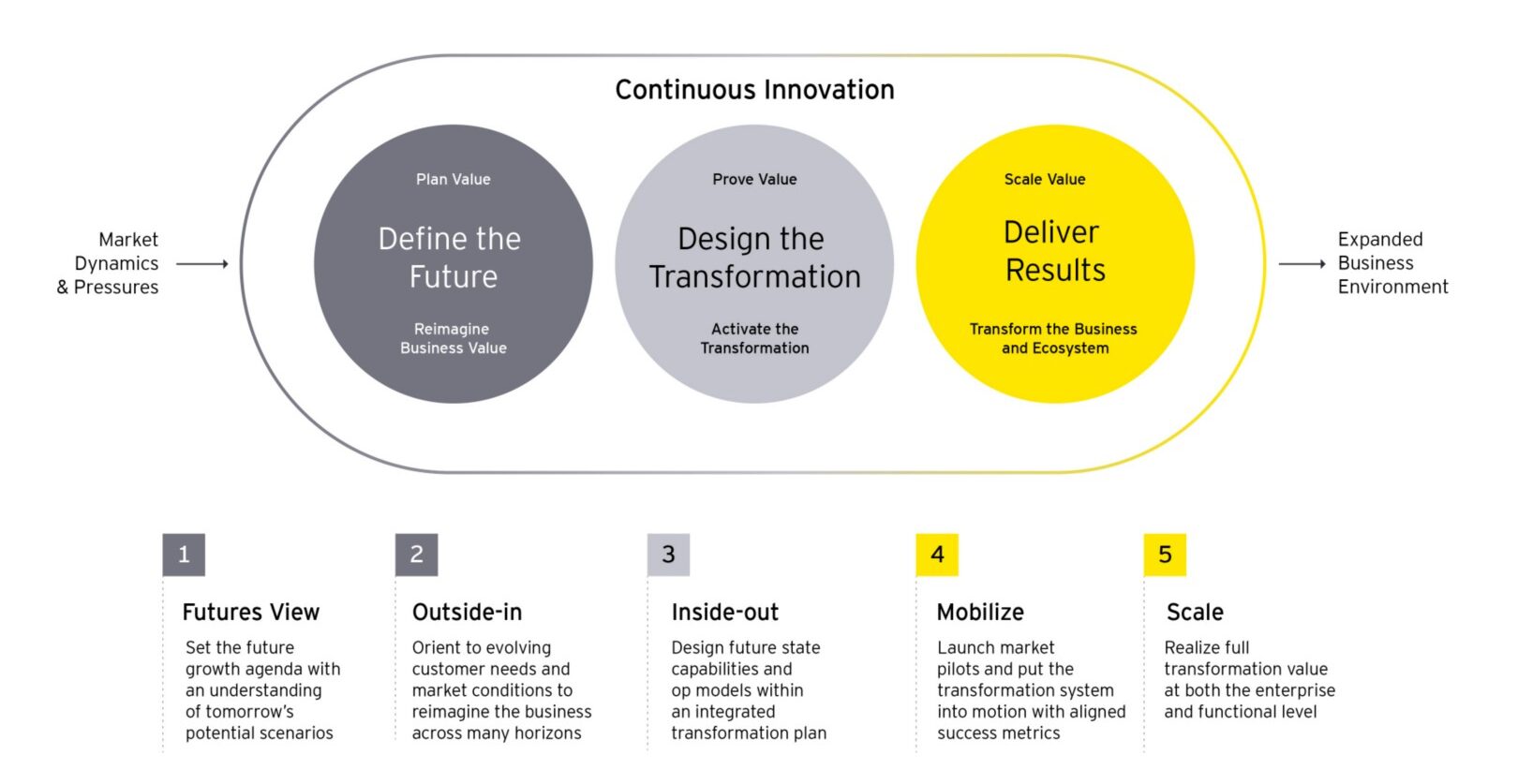
Image 2: A chart showing the continuous innovation process which defines the future growth agenda, designs the transformation plan to deliver results both at the enterprise and functional level. Source: EY
Design the Transformation With a Hands-On Approach to Innovation
Rapid prototyping is an essential step for manufacturers to substantiate their future views and refine perspectives on must-have innovations. Multiple, accelerated iterations of both physical products and digital offerings are important for assessing features and costs in the context of various customer expectations, demand levels and competition scenarios.
Making the future tangible will pay dividends in the design phase of the transformation. Understanding necessary enterprise-wide adaptations – from specific technology or talent enhancements to new business models – will inform an achievable, cross-functional plan. The ability to “show your work” will also help build support across various internal constituencies as they are enlisted in the effort.
Start with the end in mind
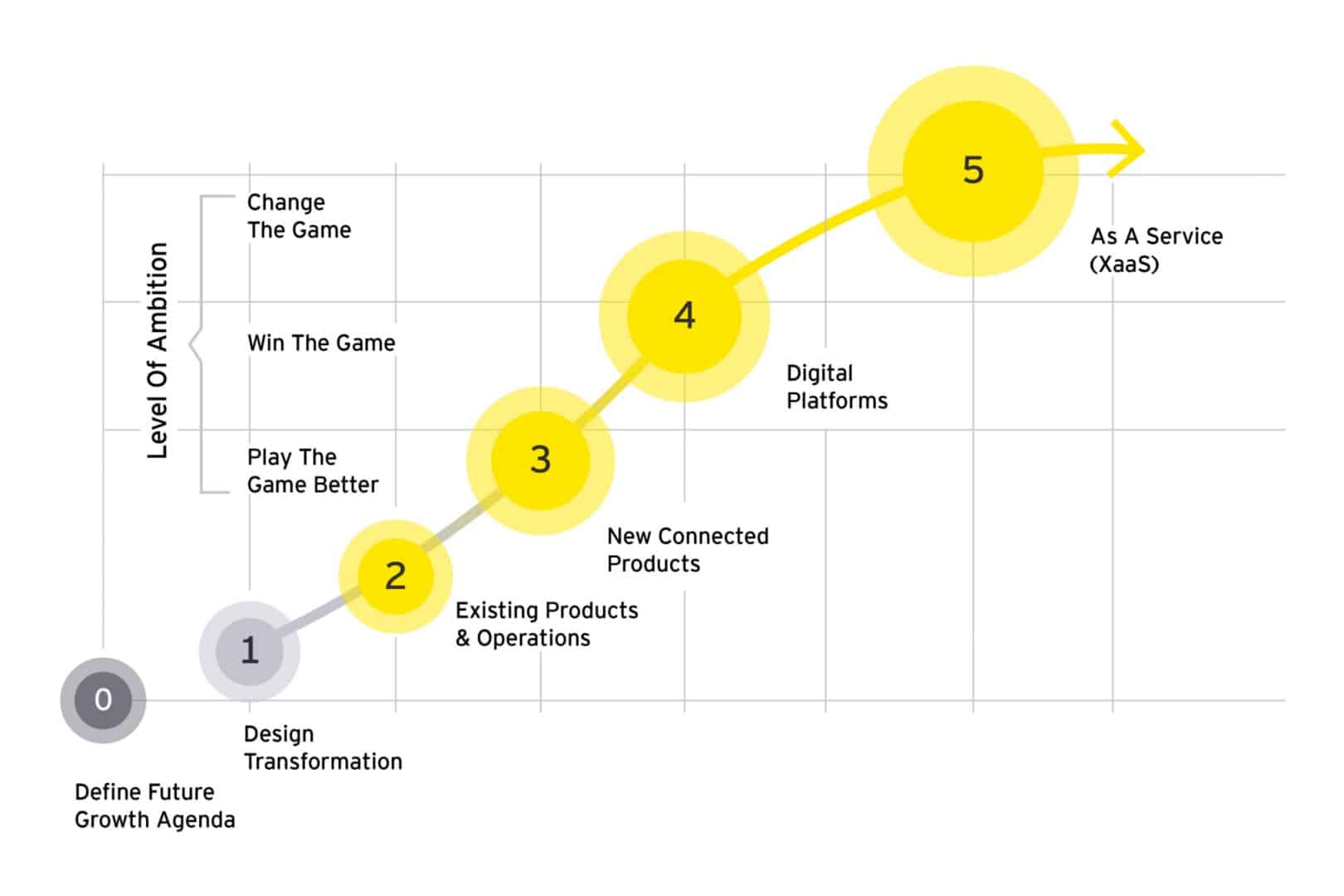
Image 3: A chart showing the continuous innovation process which defines the future growth agenda, designs the transformation plan, analyzes existing products and operations, connects new products, embeds digital platforms to redesign As-A-Service (XaaS). Source: EY
Accelerate Results By Incubating New Business Model Concepts
When future growth depends on technologies, customer expectations or new value pools that are not addressed by a manufacturer’s current core competencies, innovation at the business model level may be a solution. For example, what are the implications of collecting, analyzing and monetizing data from a new connected product? Successfully assessing and addressing these impacts could enable manufacturers to leapfrog the competition.

“To fully realize the significant opportunities arising from disruption and the value of these investments, manufacturers must tie them to a unifying vision of where their markets are headed”
Given the enterprise-wide implications of such changes, legacy manufacturers should prioritize small-scale experimentation with a lean, internal start-up style approach. In conjunction with ongoing physical product innovation, manufacturers will want to invest in teams to explore the internal and external infrastructure and capabilities needed to support an operating model for an offering’s full lifecycle. This approach can be particularly beneficial for evaluating the technology infrastructure required for a potential new business model. By using focused, lean teams, manufacturers can leverage agile sprints to further define capabilities and architectural requirements as the transformation progresses.
Identify Ecosystem Partners to Address Critical Capability Gaps
As manufacturers innovate, they will have to decide whether their long-term strategies are better served by seeking ecosystem partners versus internally developing or acquiring new capabilities. Assessing targeted value pools and key differentiators of success can help inform these decisions.
Manufacturers whose future offerings are likely to depend on the secure sharing and analysis of data at scale will want to consider partnering with technology providers as a more efficient path to market. However, the factors to consider when choosing a mission-critical partner can be extensive, particularly given the high cost of potential failure. Legacy manufacturers can benefit from a structured process to weigh the benefits of various collaborators.
Manufacturers exploring business model innovation may also find a need for ecosystem partners outside of the technology sector. For example, future mobility business models may involve close collaboration among vehicle OEMs, energy, infrastructure and insurance firms.
Key Questions For Manufacturers Considering Reinvention
The urgency around transformation has escalated as manufacturers grapple with multi-faceted disruptions. Reactive, short-term focused responses limit the vision for enterprise-wide transformation. When thinking about the right approach, manufacturers should consider the following questions:
- Product and service innovation: How do we evolve our product portfolio to create dynamic products and services that address customer demands for smarter and more connected features, customization, and safety/security?
- Customer experience: How does a shift from B2B to B2C or D2C impact how we operate today?
- Operations:
a. How can we leverage emerging technologies to future-proof our supply chain?
b. How do we design our future manufacturing capabilities as a competitive differentiator? - Workforce and talent: How can we advance innovation as a core capability through hiring, developing, training and incentivizing our employees?
- Business model innovation: How do we innovate to drive the core business to peak profitability while simultaneously incubating new growth engines?
Answers to these questions may help leaders address strategic or operational gaps. With a clear vision of their organization’s future ambitions in mind, and a strong strategy for innovation-focused transformation, leaders can position their organizations to accelerate growth and leapfrog their competition. M
About the Authors:

David Takeuchi is EY’s Global Strategy and Transformation Business Model Innovation Leader

Jerry Gootee is EY’s Global Advanced Manufacturing Sector Leader

Claudio Knizek is EY-Parthenon’s Global Advanced Manufacturing and Mobility Leader